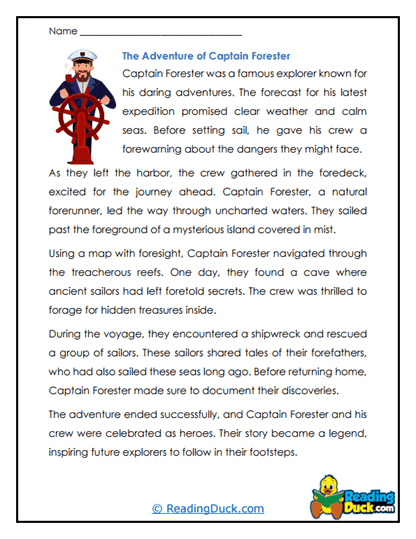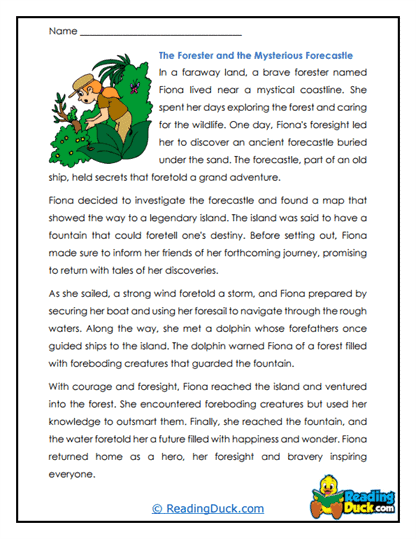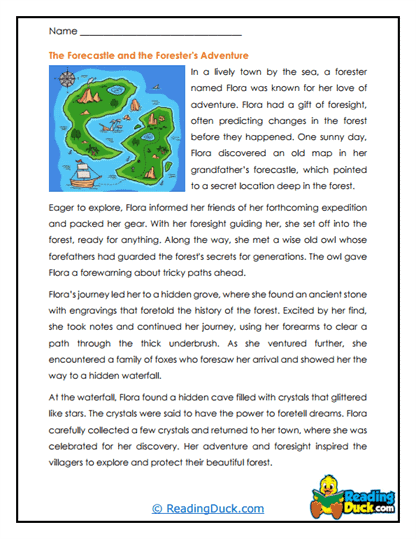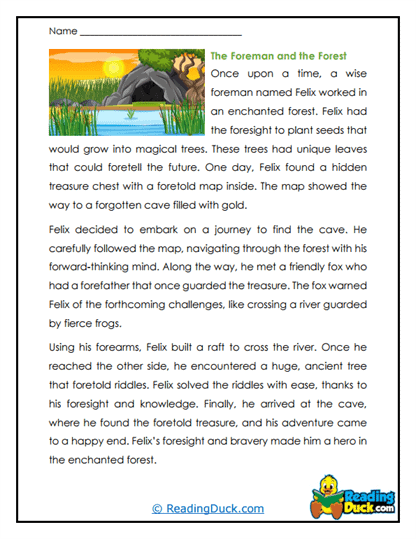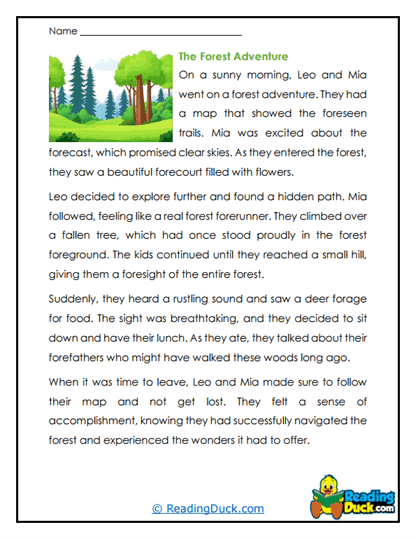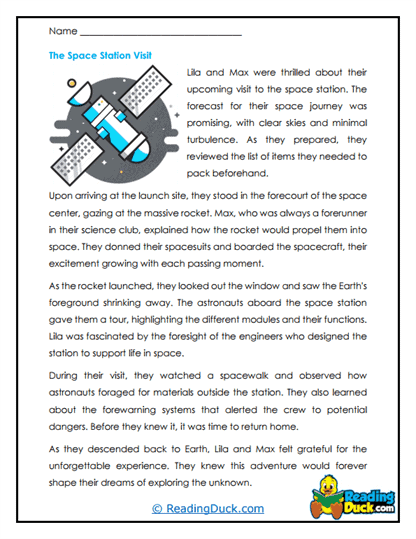Fore- Prefix Reading Passages Worksheets
About Our Fore- Prefix Reading Passages Worksheets
The Fore- Prefix Reading Passages Worksheets are specifically crafted to help students grasp the meaning and application of the prefix "fore-" through targeted reading exercises. Each worksheet in this collection features a carefully written passage filled with words that use the "fore-" prefix, providing a contextual understanding of how the prefix changes word meaning. Accompanying each passage is a vibrant image that visually engages students, helping them better connect with the content and reinforcing their comprehension of the prefix.
In addition to the reading passage and illustration, each worksheet includes multiple-choice comprehension questions designed to test students’ understanding of how the "fore-" prefix works in context. These questions ensure that students not only recognize the prefix but also comprehend its role in modifying word meanings.
The worksheets are provided in PDF format, making them easy to download, print, and distribute. This format offers flexibility for educators, parents, and tutors, enabling them to integrate these worksheets seamlessly into various learning environments. Moreover, each worksheet includes a downloadable answer key for quick and easy grading, ensuring that educators can provide timely and accurate feedback to students.
Understanding the Role of Prefixes in Vocabulary Development
Prefixes are essential components of the English language and play a critical role in vocabulary development and word decoding. A prefix is a set of letters added to the beginning of a word, changing its meaning. By learning and understanding common prefixes like "dis-," "pre-," "un-," and "re-," students are better equipped to deconstruct unfamiliar words and grasp their meanings in reading passages.
These small but significant elements allow students to recognize patterns in word formation, which in turn supports their reading comprehension. Understanding prefixes helps students become more confident readers as they gain the ability to break down complex words into manageable parts. This is especially important for young learners or those building foundational reading skills, as it enables them to approach unfamiliar vocabulary with confidence.
Learning prefixes also contributes to vocabulary retention. By repeatedly encountering these word-building blocks in different contexts, students not only memorize the prefixes but also understand how they alter word meaning. As a result, students develop a toolkit for decoding challenging words, which directly improves their reading fluency and comprehension skills.
The Power of the Fore- Prefix
The prefix "fore-" comes from Old English and generally means "before" or "in front." It is used to indicate something that happens earlier or anticipates what is ahead. This prefix is common in many everyday words, giving students ample opportunity to encounter it both in and out of the classroom. Some examples of words using the "fore-" prefix include:
- Forecast: To predict or estimate a future event.
- Foresee: To anticipate or know in advance.
- Forehead: The part of the face above the eyes, which is at the front of the head.
In the Fore- Prefix Reading Passages Worksheets, students are introduced to multiple words with the "fore-" prefix. By seeing these words used in meaningful and engaging passages, students are provided with context that helps solidify their understanding of how the prefix "fore-" modifies word meanings. This collection ensures that students gain experience not just recognizing the prefix but also applying their understanding to real-world language scenarios.
Each worksheet in this collection offers students opportunities to see the "fore-" prefix in different contexts, enhancing their comprehension and helping them become more familiar with its usage. Whether it's in predicting future events, anticipating outcomes, or describing position, students will gain confidence in their ability to interpret and use words with the "fore-" prefix.
Educational Benefits of the Fore- Prefix Worksheets
The Fore- Prefix Reading Passages Worksheets offer a range of educational benefits, designed to improve both vocabulary and reading comprehension. By working through these exercises, students will strengthen their understanding of word formation and build their reading fluency. Below are some key benefits of these worksheets:
- Contextual Learning: Students see the "fore-" prefix in action within carefully designed reading passages, helping them understand its meaning in context.
- Visual Engagement: Each worksheet includes a colorful image that supports the passage, giving students a visual reference point to reinforce comprehension.
- Comprehension Questions: Multiple-choice questions follow each passage, assessing students’ understanding of how the prefix "fore-" affects the meaning of the words.
- Easy-to-Use Format: Provided in PDF format, the worksheets are simple to download, print, and distribute, making them accessible for use in classrooms or at home.
- Answer Keys Included: A downloadable answer key accompanies each worksheet, ensuring quick and efficient grading for educators, parents, and tutors.
These worksheets offer structured and consistent practice with the "fore-" prefix, helping students internalize its meaning and usage through repeated exposure.
Integrating the Worksheets into Literacy Instruction
The Fore- Prefix Reading Passages Worksheets can be seamlessly integrated into various instructional settings. Below are some strategies for using these worksheets effectively in the classroom or at home:
- Whole-Class Activities: Use the worksheets as part of a prefix-focused lesson. Start by introducing the "fore-" prefix and its meaning, then have students read the passage and answer the comprehension questions together. This approach encourages class discussions and collaborative learning.
- Small Group Work: Divide students into small groups and assign each group a worksheet. After completing the passage and questions, ask the groups to share their answers and discuss how the "fore-" prefix changes word meanings. This encourages peer learning and critical thinking.
- Independent Practice: These worksheets are perfect for independent work, allowing students to practice decoding words with the "fore-" prefix at their own pace. They can also be assigned as homework for additional practice.
- Supplemental Resource: Incorporate the worksheets into your existing vocabulary lessons. Use them as supplemental activities to reinforce prefix learning, or introduce new prefixes as part of your language instruction.
By using these worksheets in various instructional formats, educators can provide students with well-rounded opportunities to practice and master the "fore-" prefix.
Enhancing Vocabulary Across the Curriculum
These worksheets serve as part of a broader vocabulary-building curriculum, ensuring students develop a comprehensive understanding of prefixes and their role in word formation. By tracking and applying newly learned prefixes like "fore-," students improve their ability to decode unfamiliar words and expand their vocabulary.
The structured format of the worksheets provides repeated exposure to the "fore-" prefix, helping students solidify their understanding over time. By incorporating these worksheets into their learning routine, students are better equipped to tackle complex vocabulary in future readings.
Additionally, integrating multiple prefixes—such as "dis-," "pre-," "un-," and "re-"—across lessons ensures that students receive consistent practice and build on their knowledge sequentially. This cumulative learning approach reinforces their understanding of how prefixes work and strengthens their long-term retention of vocabulary skills.
Decoding Word Meaning Through Prefixes
Understanding prefixes is a crucial component of language development, and mastering them gives students an edge in decoding unfamiliar words. Prefixes like "fore-" provide valuable clues for determining the meaning of a word, allowing students to approach challenging vocabulary with confidence. For example, knowing that "fore-" often means "before" enables students to decode words like "forewarn" (to warn in advance) or "forethought" (thinking ahead).
The Fore- Prefix Reading Passages Worksheets give students the opportunity to practice applying this knowledge in meaningful contexts, using real-world reading passages to reinforce their learning. The multiple-choice comprehension questions that follow each passage ensure that students grasp the full meaning of the prefix and how it alters the words.
Conclusion: Unlock Vocabulary with Prefix Practice
The Fore- Prefix Reading Passages Worksheets are an invaluable resource for educators, parents, and tutors looking to help students strengthen their vocabulary and reading comprehension skills. By focusing on the "fore-" prefix, these worksheets provide structured practice that enhances students' ability to decode unfamiliar words and understand how prefixes modify meaning.
These engaging and accessible worksheets are ideal for use in a variety of settings, offering flexibility and ease of use in the classroom, for homework, or as part of a broader literacy curriculum. By regularly working with prefixes like "fore-," students will gain confidence in their language skills and become more proficient, independent readers.
